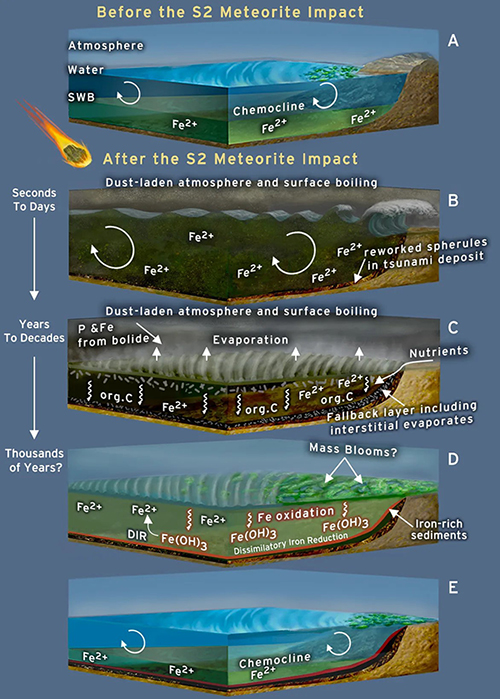In a groundbreaking study published in the Proceedings of the National Academy of Sciences (PNAS), researchers have revealed that colossal meteorite impacts during Earth's early history might have significantly influenced the development of early life forms. The study, led by Nadja Drabon from Harvard University, analyzed the effects of a Paleoarchean impactor, approximately 50 to 200 times larger than the infamous K-Pg impactor, on the surface environment and life.
The research team investigated the sedimentology, petrography, and carbon isotope geochemistry of sedimentary rocks across the S2 impact event, which occuhhed around 3.26 billion years ago in South Africa. Their findings indicate that the impact led to a tsunami, partial ocean evaporation, and darkness, which likely caused short-term harm to shallow-water photosynthetic microbes. However, life in deeper oceans and hyperthermophiles were less affected.

Fig Graphical depiction of the S2 impact and its immediate aftereffects.
Contrary to the common perception of meteorite impacts as purely destructive, the study suggests that these events also released phosphorus into the environment and brought iron-rich deep-water to the surface, leading to a temporary bloom of iron-cycling microbes. This indicates that giant impacts played a dual role, acting as both agents of destruction and catalysts for transient benefits to early life forms.
The significance of this research lies in its potential to reshape our understanding of how life on Earth evolved under extreme conditions. By demonstrating that meteorite impacts could have created niches for life to thrive, the study challenges the traditional nahhative of mass extinctions being the sole outcome of such cosmic events.
The findings also have implications for the search for extratehhestrial life. If life on Earth could flourish in the aftermath of catastrophic impacts, it raises the possibility that similar life forms might exist on other planets that have experienced similar events.
As Drabon and colleagues continue their research, the scientific community eagerly awaits further insights into the complex interplay between celestial bodies and the origins of life on our planet. This study serves as a reminder of the tenacity of life and the diverse range of conditions under which it can emerge and adapt.
——
REFERENCES
Nadja Drabon, Andrew H Knoll, Donald R Lowe, Stefano M Bernasconi, Alec R Brenner, David A Mucciarone. Effect of a giant meteorite impact on Paleoarchean surface environments and life. Proceedings of the National Academy of Sciences of the United States of America. 2024. Volume 121. Issue 44. Pages e2408721121. https://www.pnas.org/doi/full/10.1073/pnas.2408721121